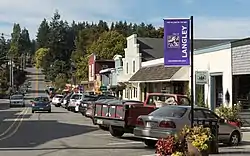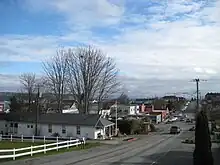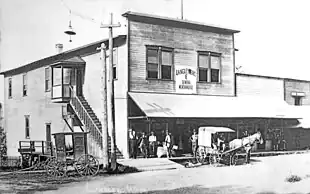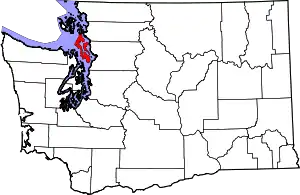Langley, Washington
Langley is a city in Island County, Washington, United States. It sits near the south end of Whidbey Island, overlooking the Saratoga Passage. It is the third largest incorporated area on Whidbey. The population was 1,035 at the 2010 census, while the ZCTA for Langley's post office had a population of 4,878.[2] The geographical area of the city is only 0.8 square miles (2.1 km2) but the ZCTA covers 26.20 square miles (67.9 km2).[2]
Langley | |
|---|---|
 Main Street in Langley | |
 Seal | |
| Nickname: "The Village by the Sea" | |
 Location of Langley in Washington | |
| Coordinates: 48°2′12.92″N 122°24′30.6″W | |
| Country | United States |
| State | Washington |
| County | Island |
| Incorporated | February 26, 1913 |
| Government | |
| • Type | Mayor-council government with 5 Council Members |
| • Mayor | Scott Chaplin |
| Area | |
| • City | 1.58 sq mi (4.09 km2) |
| • Land | 1.01 sq mi (2.61 km2) |
| • Water | 0.57 sq mi (1.48 km2) |
| • Metro | 26.2 sq mi (67.86 km2) |
| Elevation | 0–90 ft (0–27.7 m) |
| Population | |
| • City | 1,035 |
| • Estimate (2019)[3] | 1,140 |
| • Density | 1,130.95/sq mi (436.67/km2) |
| • Metro | 4,878 |
| Time zone | UTC-8 (PST) |
| • Summer (DST) | UTC-7 (PDT) |
| ZIP code | 98260 |
| Area code | 360 564 |
| Telephone exchanges | 221, 321, 331, 341, 730 |
| FIPS code | 53-38355[4] |
| GNIS feature ID | 1512376[5] |
| Annual budget | 2012, approximately $5.5 million |
| Website | City of Langley |

Langley is served by South Whidbey Fire/EMS, the Langley Police Department and South Whidbey School District #206; the school district offices are located there. The current mayor is Scott Chaplin.[6]
History
Langley was founded in the 1890s by Jacob Anthes,[7] and was named for J.W. Langley of Seattle.[8] In 1902, Anthes built a logger bunkhouse that still stands in the downtown core (it functions today as the South Whidbey Historical Society Museum).[9] Langley was officially incorporated on February 26, 1913.
At some point in the late 1900s, a number of 4H rabbits escaped their enclosures at the Island County Fair and went on to thrive as a large feral population initially residing around the county fairgrounds and later spreading throughout Langley and south Whidbey Island. In the 2010s the rabbits became a controversial issue in local politics, with citizens and groups advocating for public policy positions from removal and relocation to outright eradication. Some favored controlling the rabbit population using raptors, while other voices advocated for a more lenient position of community acceptance.[10][11][12][13]
The Olympic Club

The Dog House was opened in 1908 and home to an elite gentlemen's club called "The Olympic Club," however, the founder on opening night realized that he didn't have enough money to pay the entertainers – so he left with everyone's money and skipped town.[14] Over the years, the building acted as host to many businesses, adding to the building's rich and vibrant history.
During the Prohibition, the building went back to its roots and played host to underground boxing and wrestling matches which were illegal on the mainland.
When the Prohibition ended, the club became a public bar, and operated as a restaurant and bar until its closure in 2008.[15] The Clyde Theatre began in the top floor of this building.

Indigenous history
Langley has hosted several Indigenous tribes throughout oral history, going back thousands of years, many names and stories of whom are lost to us.
For example, speculation is that a tribe living in the area was killed in a tsunami caused by a landslide on Camano Island, and they were early residents of the area, to include a village on Hat Island.[16]
Franz Boas and other anthropologists have recorded the oral history of several members of a lost tribe walking along the beach near Langley, and being turned into large stones by a god called the Changer.[17] The Changer is also known as the Creator to many of the local tribes.

Langley was at the time of contact, the permanent home to members of the Snohomish tribe, who lived in a large village at what is now called "Sandy Point," but what was at that time known as TSEHT-skluhks ('ragged nose').[18] At the moment of first contact, there were several hundred Snohomish tribal members living within what is now called Langley.[19]
War happened irregularly among the tribes of the lower Salish region, but it did happen.[20] More frequently, however, were raids by the tribes from the North; those living in the areas of present-day Vancouver Island, the San Juans, and what is now the City of Vancouver. Especially feared among the residents of this area was a tribe known as the Haida; with a dedicated unit of fierce warfighters, guided by the spirits to embrace war. Some scholars have compared the Haida to the Vikings.[20][21]

Government and politics
The City of Langley operates under a mayor–council form of government. The mayor and city councilmembers are elected to four-year terms. The City Council enacts ordinances and resolutions, holds public hearings, receives citizen comments, authorizes payment of City funds, approves contracts, and creates committees and boards to assist in the operation of city government. The City Council meets on the first and third Monday of each month in City Hall at 5:30pm. The Mayor presides over Council meetings and is responsible for the administration of City government.
The current mayor is Scott Chaplin, elected by the City Council in 2021[6] to replace the former mayor, Tim Callison who resigned.[22]
Langley is also served by a sewage treatment facility on Coles Road (for now, in the middle of the woods), operated by the city's Public Works Department.[23]
Paull Schell, the former Mayor of Seattle, was a big influence on city politics in the 90s and 2000s, constructing the Inn at Langley.[24]
Langley Marina
Available Services & Facilities
- Vessel Moorage
- Accessible Restroom
- Showers
- Accessible Parking
- Boat Ramp
- Beach Access
- Accessible Fishing[25]
In January 2009, the City of Langley transferred ownership of the Langley Marina to the Port of South Whidbey. The small boat harbor consists of 41 slips and 330 feet of linear moorage that can accommodate vessels up to 190 feet (57.6 meters).
Facilities include restrooms and showers, water and 110v 20, 30, 50 and 100 amp power at the docks, a floating pump out station, and a boat launch. No fuel is available.[26]
Schools
Langley is in the South Whidbey School District, which has been in declining in attendance over the last two decades.
Home of the Cougars Closed Permanently in 2017

The first school constructed in Langley, the original Langley High School, and what was eventually the Langley Middle School campus after the new High School was constructed – home of the Cougars – is now completely defunct, managed by various local nonprofits and companies.[27] There are still two time capsules buried next to the Middle School flagpole, the next one scheduled is to be opened in the year 2055, buried in 2005.
The main building has been converted into an artistic community classroom, known as the South Whidbey Community Center.[28]
The gym has been converted into a CrossFit studio. The football field and track and field are still maintained by the Community Center, and the
The science building is now home to the Veterans Resource Center of South Whidbey.[29]
Whidbey Children's Theatre is now housed in the former school auditorium.[29]
The library is now home to the Whidbey Dance Theatre and the Island Dance Studio.[29]
High School / Middle School
The home of the Eagles absorbed grades 7–8 with the closure of the Middle School in 2017. Today, grades 7-12 are now housed at the High School.
Elementary School / Primary School
The home of the Dolphins and the home of the Orcas, constructed next door to one another, downsized and have now been merged into a singular entity, still occupying some classrooms in both campuses. Grades K – 6 now are housed at this Elementary School campus.
Events
Mystery Weekend is a yearly mystery game event occurring the last weekend in February. A fake newspaper story is run in the South Whidbey Record or a fake newspaper can be purchased from the Visitor & Information Center, detailing the persons involved and instructing players to seek out characters played by local residents.[30]
The Welcome the Whales Festival and parade is held at the beginning of April each year.
The Djangofest NW Music Festival is held in September each year. This five-day festival celebrates the gypsy jazz style of Django Reinhardt, and features workshops, concerts, and impromptu jam sessions around town.
The Whidbey Island Area Fair is held in July at the Island County Fairgrounds in Langley. The original Island County Fair Association was formed in 1912, predating the incorporation of Langley itself.[31]
Choochokam was an event that ran for annually in this town for 41 years, before funding dried up. Local groups are discussing how to bring this festival back.[32]
Geography
Langley is located at 48°2′13″N 122°24′31″W (48.036922, -122.408500).[33]
According to the United States Census Bureau, the city has a total area of 1.08 square miles (2.80 km2), all of it land.[34]
Demographics
| Census | Pop. | Note | %± |
|---|---|---|---|
| 1920 | 274 | — | |
| 1930 | 268 | −2.2% | |
| 1940 | 338 | 26.1% | |
| 1950 | 427 | 26.3% | |
| 1960 | 448 | 4.9% | |
| 1970 | 547 | 22.1% | |
| 1980 | 650 | 18.8% | |
| 1990 | 845 | 30.0% | |
| 2000 | 959 | 13.5% | |
| 2010 | 1,035 | 7.9% | |
| 2019 (est.) | 1,140 | [3] | 10.1% |
| U.S. Decennial Census[35] | |||
2010 census
As of the census[2] of 2010, there were 1,035 people, 555 households, and 271 families residing in the city. The population density was 958.3 inhabitants per square mile (370.0/km2). There were 678 housing units at an average density of 627.8 per square mile (242.4/km2). The racial makeup of the city was 94.1% White, 0.1% African American, 0.6% Native American, 1.6% Asian, 0.1% Pacific Islander, 0.7% from other races, and 2.8% from two or more races. Hispanic or Latino of any race were 3.2% of the population.
There were 555 households, of which 16.6% had children under the age of 18 living with them, 39.1% were married couples living together, 7.6% had a female householder with no husband present, 2.2% had a male householder with no wife present, and 51.2% were non-families. 43.6% of all households were made up of individuals, and 23.6% had someone living alone who was 65 years of age or older. The average household size was 1.86 and the average family size was 2.51.
The median age in the city was 57 years. 14% of residents were under the age of 18; 3.4% were between the ages of 18 and 24; 14.4% were from 25 to 44; 39.8% were from 45 to 64; and 28.4% were 65 years of age or older. The gender makeup of the city was 40.9% male and 59.1% female.
2000 census
As of the 2000 census,[4] there were 959 people, 486 households, and 268 families residing in the city. The population density was 1,165.9 people per square mile (451.6/km2). There were 542 housing units at an average density of 658.9 per square mile (255.2/km2). The racial makeup of the city was 96.25% White, 0.31% African American, 0.42% Native American, 0.52% Asian, 0.42% from other races, and 2.09% from two or more races. Hispanic or Latino of any race were 1.88% of the population.
There were 486 households, out of which 24.3% included children under the age of 18, 40.9% were married couples living together, 12.1% had a female householder with no husband present, and 44.7% were non-families. 39.9% of all households were made up of individuals, and 21.2% had someone living alone who was 65 years of age or older. The average household size was 1.97 and the average family size was 2.61.
Langley's population was spread out, with 19.7% under the age of 18, 5.8% from 18 to 24, 15.7% from 25 to 44, 35.5% from 45 to 64, and 23.3% who were 65 years of age or older. The median age was 49 years. For every 100 females, there were 76.9 males. For every 100 females age 18 and over, there were 72.3 males.
The median income for a household in the city was $34,792, and the median income for a family was $51,563. Males had a median income of $41,750 versus $30,125 for females. The per capita income for the city was $24,940. About 5.2% of families and 10.6% of the population were below the poverty line, including 10.7% of those under age 18 and 6.6% of those age 65 or over.
References
- "2019 U.S. Gazetteer Files". United States Census Bureau. Retrieved August 7, 2020.
- "U.S. Census website". United States Census Bureau. Retrieved December 19, 2012.
- "Annual Estimates of the Resident Population for Incorporated Places in Washington: April 1, 2010 to July 1, 2019". United States Census Bureau. May 2020. Retrieved May 27, 2020.
- "U.S. Census website". United States Census Bureau. Retrieved January 31, 2008.
- "Langley". Geographic Names Information System. United States Geological Survey, United States Department of the Interior.
- "Langley council picks Chaplin for mayor over fellow council member". Retrieved October 6, 2021.
- "History of Langley". Retrieved December 17, 2020.
- Meany, Edmond S. (1923). Origin of Washington geographic names. Seattle: University of Washington Press. p. 142.
- "The South Whidbey Historical Society Museum Logger Bunk House | South Whidbey Historical Society".
- "Hundreds of Bunnies Have Overrun This Washington City".
- "'It's not cute anymore': Bunny brouhaha as Langley is overrun with rabbits". October 7, 2015.
- Rabbits raid Langley City Hall garden, but overall population appears to be on the decline, South Whidbey Record, April 4, 2017, accessed September 13, 2019.
- Langley's rabbit discussion returns; Port weighs options, South Whidbey Record, January 13, 2018, accessed September 13, 2019.
- "Historical Langley – 230 First St". ww2.whidbey.net. Retrieved July 16, 2023.
- "PCAD – Olympic Building, Langley, WA". pcad.lib.washington.edu. Retrieved July 16, 2023.
- https://www.tulaliptribes-nsn.gov/Base/File/TTT-PDF-Section-3-second-half-mitigation-actions
- https://www.gusd.net/cms/lib/CA01000648/Centricity/Domain/2027/AmericanIndianMythsAndLegends.pdf
- https://southwhidbeyhistory.org/2018/04/before-it-was-called-sandy-point/
- https://southwhidbeyhistory.org/special-topics/the-native-peoples/
- https://bookstore.gpo.gov/products/handbook-north-american-indians-v-7-northwest-coast
- https://www.historymuseum.ca/cmc/exhibitions/aborig/haida/havwa01e.html
- ""Langley mayor moving outside city, resigning"". Retrieved October 6, 2021.
- "Langley Wastewater Treatment Facility". langleywa.org. Retrieved July 16, 2023.
- "Whidbey Island beach home is new and already full of memories". The Seattle Times. May 22, 2015. Retrieved July 16, 2023.
- "Home". Port of South Whidbey. Retrieved July 16, 2023.
- "Harbor at Langley". langleywa.org. Retrieved July 16, 2023.
- "Goodbye Langley Middle School; board votes to shutter school indefinitely". South Whidbey Record. January 27, 2017. Retrieved July 16, 2023.
- "About the South Whidbey Community Center | South Whidbey Community Center". southwhidbeycommunitycenter.org. Retrieved July 16, 2023.
- "Campus Map | South Whidbey Community Center". southwhidbeycommunitycenter.org. Retrieved July 16, 2023.
- "Mystery Weekend 2018". Retrieved August 18, 2017.
- http://fair.whidbeyislandfair.com/home/history Whidbey Island Area Fair
- https://www.southwhidbeyrecord.com/news/two-groups-look-at-reviving-choochokam/
- "US Gazetteer files: 2010, 2000, and 1990". United States Census Bureau. February 12, 2011. Retrieved April 23, 2011.
- "US Gazetteer files 2010". United States Census Bureau. Archived from the original on July 2, 2012. Retrieved December 19, 2012.
- United States Census Bureau. "Census of Population and Housing". Retrieved August 31, 2014.
